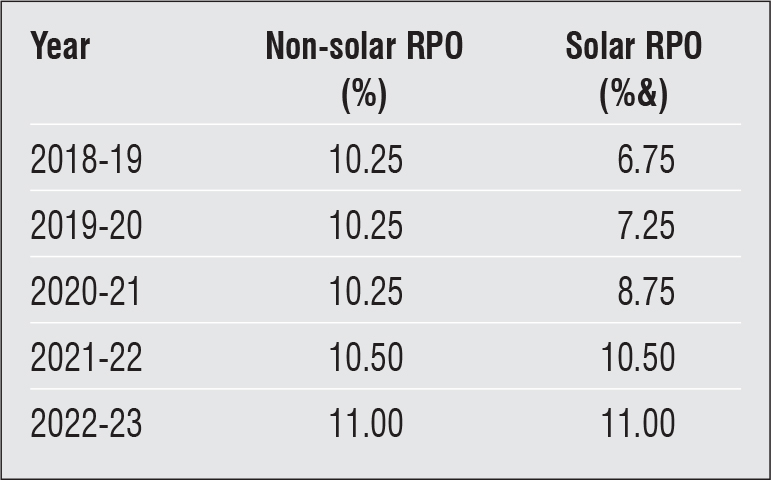 The small hilly state of Uttarakhand was formed in the year 2000, and the premise was that its abundant hydropower and tourism potential would make the state profitable. Nearly two decades later, it is safe to say that the state has been largely successful in leveraging this potential. However, large hydropower projects have been witnessing a slowdown in Uttarakhand, especially after the flood disaster of 2013 and the concerns raised about the ill-effects of setting up large hydropower projects in ecologically sensitive areas. To avoid compromising the energy security of the state, the local authorities have been promoting solar power, biomass and other renewable energy sources on a large scale through various schemes and policy measures. In an exclusive interview with Renewable Watch, Radhika Jha, secretary to the chief minister and secretary, power, Government of Uttarakhand, highlights the recent developments in the state’s renewables space in terms of the policy measures adopted and the future plans…
The small hilly state of Uttarakhand was formed in the year 2000, and the premise was that its abundant hydropower and tourism potential would make the state profitable. Nearly two decades later, it is safe to say that the state has been largely successful in leveraging this potential. However, large hydropower projects have been witnessing a slowdown in Uttarakhand, especially after the flood disaster of 2013 and the concerns raised about the ill-effects of setting up large hydropower projects in ecologically sensitive areas. To avoid compromising the energy security of the state, the local authorities have been promoting solar power, biomass and other renewable energy sources on a large scale through various schemes and policy measures. In an exclusive interview with Renewable Watch, Radhika Jha, secretary to the chief minister and secretary, power, Government of Uttarakhand, highlights the recent developments in the state’s renewables space in terms of the policy measures adopted and the future plans…
What has been Uttarakhand’s overall experience in the renewable energy space? What have been the recent achievements in this sector?
Uttarakhand is richly endowed with natural renewable energy sources. The state has 3,000 MW, 262 MW, 1,223 MW, 20 MW and 100 MW of power potential in the small-hydro, biomass, solar, geothermal and waste-to-energy segments respectively. These environmentally clean sources can be helpful in generating electricity. The cumulative grid-connected installed capacity in Uttarakhand currently stands at 524 MW. This includes 73 MW of cogeneration-based, 255 MW of solar photovoltaic, and 196 MW of micro- and mini-hydro power capacity.
What are the upcoming renewable energy tenders? What are the key features of the Chief Minister Solar Self-employment Scheme? What are the other upcoming or ongoing schemes in the state to promote renewable energy?
The state calls for tenders as per the requirement of power by Uttarakhand Power Corporation Limited (UPCL) in order to ensure compliance with the renewable purchase obligation (RPO) as specified by the regulatory commission.
We recently allotted 1,060 kW of pine needle-based power projects to 38 developers as well as briquette production projects with a cumulative capacity of 3,200 million tonnes per annum to two developers. In addition to this, last month we received proposals from 23 developers for the installation of a cumulative capacity of 750 kW of pine-to-power generation projects.
The state has also allotted a total of 203 MW of solar power projects to 283 developers. These projects have been allotted exclusively to permanent residents of Uttarakhand and will be developed on barren uncultivated land in hilly terrain.
Alongside this, the state has recently launched the Mukhyamantri Saurya Swarojgar Yojana with a target to develop a total of 10,000 solar power projects, each of 25 kW capacity. The projects will be allotted to unemployed youth, small-scale farmers and migrants returning to Uttarakhand due to the Covid-19 pandemic. The project sites will be selected in such a way that the aerial distance between a selected site and the nearest transformer is not more than 300 metres in the hilly areas and 100 metres in the plains. The scheme aims to provide employment to 10,000 individuals directly and 20,000 indirectly.
What measures have been taken to promote rooftop solar in the state? What are the provisions of the state government for promoting open access projects?
The state has developed an online portal system for the allotment of rooftop solar power projects. Net metering guidelines pertaining to tariffs, scheduling and connectivity have already been notified by Uttarakhand Electricity Regulatory Commission (UERC). Applications for a cumulative capacity of 9 MW have been received till date through the online portal, of which 1 MW has been successfully installed. Besides this, an MoU has been signed with GiZ for carrying out an assessment of demand aggregation and creating publicity for rooftop solar power in the state.
 What are the challenges that Uttarakhand faces in the renewable energy space? What has been the uptake in the small-hydro space in recent years?
What are the challenges that Uttarakhand faces in the renewable energy space? What has been the uptake in the small-hydro space in recent years?
Land in the state of Uttarakhand is very expensive and is available in small patches. Big patches of land, which are apt for solar power generation, are quite scarce. The biggest solar power project installed in the state till date is of 20 MW capacity, set up by Emami Power in Udham Singh Nagar district.
The perunit cost of generation from smaller solar projects is higher than that from bigger ultramega power projects due to economies of scale. Moreover, the state provides power to industrial and commercial consumers at a far cheaper rate than the perunit cost of generation from a solar power plant.
Coming to your second question with regard to recent developments in the small-hydropower space, the state government has come out with a policy to promote such projects. It has been subdivided into two categories: up to 2 MW and from 2 MW to 25 MW. While the Uttarakhand Renewable Energy Development Agency has been made the nodal agency for projects up to 2 MW, Uttarakhand Jal Vidyut Nigam Limited is the nodal agency for projects from 2 MW to 25 MW.
Micro-hydro projects, that is, projects with capacities up to 2 MW, are reserved for Panchayati Raj Institutions (PRIs). PRIs have an option to execute these projects either on their own or with the aid of a special purpose vehicle (SPV) partner , selected through a bidding process. Till date, a total of 75 detailed project reports have been prepared for small-hydro power projects with a cumulative capacity of 35.55 MW. We are in the process of allotting these projects either to local panchayats or to SPV developers as the case may be.
What is the RPO compliance status in the state and what are the plans to ensure 100 per cent compliance?
The UERC, under the Uttarakhand Electricity Regulatory Commission (Tariff and Other Terms for Supply of Electricity from Renewable Energy Sources and Non-fossil Fuel-based Cogenerating Stations) Regulations, 2018, has notified distribution licensees, captive users and open access customers as obligated entities that are obligated to fulfil their RPO requirements.
UPCL, being one such obligated entity, has been fulfilling its solar as well as non-solar RPO in a timely manner, every year. In fact, UPCL has overachieved its RPO target in 2019-20 and is, therefore, applying to avail of renewable energy certificate benefits for the excess power procured over and above as required to fulfil its RPO. The RPO targets as stipulated by the UERC are as follows:
What is your perspective on energy storage integration, especially in remote regions? What is the state’s plan for renewable energy uptake in the future?
Grid stability is one of the major challenges we are facing today. Energy storage could be a scalable solution to this issue, especially in remote regions. We will be happy to embrace an environment-friendly and financially viable energy storage integration technology across the state.
Recently, we signed an MoU with the Solar Energy Corporation of India (SECI) for the development of a floating solar power plant on water bodies such as Trimura, Haripura and the Tehri dam. SECI is preparing a detailed site investigation report for the same.



